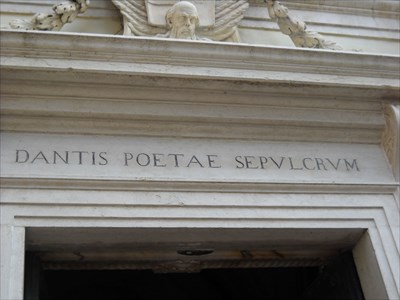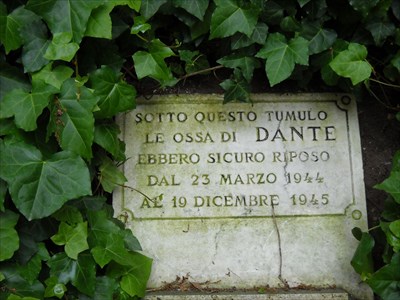
 The Tomb of Dante was built between 1780 and 1782 by the will of the Apostolic Legate Luigi Valenti Gonzaga. From the project of the architect of Ravenna Camillo Morigia, respecting the neoclassical style of the time, the aim was to restore nobility and honor to the Great Poet, until then welcomed in a simple chapel that had been restored several time.
The Tomb of Dante was built between 1780 and 1782 by the will of the Apostolic Legate Luigi Valenti Gonzaga. From the project of the architect of Ravenna Camillo Morigia, respecting the neoclassical style of the time, the aim was to restore nobility and honor to the Great Poet, until then welcomed in a simple chapel that had been restored several time.
The spoils of the Poet, after having been preserved for a long time by the Franciscans to hide them from the Florentines who claimed them, were found in 1865 and from that time deposited in the Tomb.
The interior is decorated with polychrome marbles from 1921, on the occasion of the sixth centenary of the death of Dante. In addition, on the wall in front of the entrance, above the sarcophagus is a bas-relief by Pietro Lombardo, made in 1483, depicting the poet in front of a pulpit.
A bronze and silver crown, offered in 1921 by the victorious army of the First World War, stands at the foot of the tomb. On the right side you can see the elegant jar made by Giovanni Mayer and offered by the Julian and Dalmatian cities in 1908.
On the side of the Mausoleum of Dante you will find the "Quadrarco di Braccioforte". An ancient oratory that takes its name from a legend: two people would have taken an oath here, invoking the Savior's "Strong Arm" (in Italian, "braccio forte"), whose image was represented in this place.
In the Quadrarco were placed two sarcophagi of the 5th century, which were then used by the families Pignata and Traversari. In the middle of the garden, an abundance of ivy covered land reminds visitors of the place where the poet's remains were hidden during the Second World War.
The Tomb of Dante, the Quadrarco Garden and the Franciscan cloisters, where the Museum dedicated to Dante Alighieri is located, are part of the so-called "Zone of Silence", as a sign of respect for the grave of the Great Poet took its present appearance in 1936, thanks to the project of the architect Giorgio Rosi.
Sources : The Tomb


 Le Tombeau de Dante fut construit entre 1780 et 1782 par la volonté du Légat apostolique Luigi Valenti Gonzaga. Du projet de l’architecte de Ravenne Camillo Morigia, en respectant le style néoclassique de l’époque, le but était de restituer noblesse et honneur aux Grand Poète, jusqu’à ce moment-là accueilli dans une simple chapelle qui avait été restaurée plusieurs fois.
Le Tombeau de Dante fut construit entre 1780 et 1782 par la volonté du Légat apostolique Luigi Valenti Gonzaga. Du projet de l’architecte de Ravenne Camillo Morigia, en respectant le style néoclassique de l’époque, le but était de restituer noblesse et honneur aux Grand Poète, jusqu’à ce moment-là accueilli dans une simple chapelle qui avait été restaurée plusieurs fois.
Les dépouilles du Poète, après avoir été conservées pendant longtemps par les franciscains pour les cacher des Florentins qui les réclamaient, furent retrouvées en 1865 et à partir de ce moment-là déposées dans le Tombeau.
L’intérieur est décoré par des marbres polychromes originaires du 1921, à l’occasion du sixième Centenaire de la mort de Dante. De plus, sur le mur devant l’entré, au-dessus du sarcophage, se trouve un bas-relief de Pietro Lombardo, réalisé en 1483, représentant le poète devant un pupitre.
Une couronne de bronze et argent, offerte en 1921 par l’armée victorieuse de la Première Guerre Mondiale, se situe au pied du tombeau. Sur le côté droit, vous pourrez apercevoir l’élégante fiole réalisée par Giovanni Mayer et offerte par les villes juliennes et dalmates en 1908.
Sur le côté du Mausolée de Dante vous trouverez le « Quadrarco di Braccioforte ». Un ancien oratoire qui tire son nom d’une légende : deux personnes auraient prêtées serment ici en invoquant le « Bras Fort » du Sauveur (en italien, « braccio forte »), dont l’image était représentée dans ce lieu.
Dans le Quadrarco ont été placés deux sarcophages du Vème siècle, qui ont ensuite été utilisés par les familles Pignata et Traversari. Au milieu du jardin, un cumul de terre recouvert de lierre rappelle aux visiteurs le lieu où la dépouille du Poète a été cachée pendant la Seconde Guerre Mondiale.
Le Tombeau de Dante, le jardin du Quadrarco et les cloîtres franciscains, où se situe d’ailleurs le Musée dédié à Dante Alighieri, font partie de la dite « Zone du Silence », en signe de respect au lieu de sépulture du Grand Poète qui pris son aspect actuel en 1936, grâce au projet de l’architecte Giorgio Rosi.
Sources : Le Tombeau


 Tomba di Dante è stato costruito tra il 1780 e il 1782 per volontà del legato apostolico Luigi Valenti Gonzaga. Progetto architetto ravennate Camillo Morigia, nel rispetto dello stile neoclassico del tempo, l'obiettivo era quello di ripristinare nobiltà e onorare il Sommo Poeta, fino a quel momento accolti in una semplice cappella che era stata restaurata diverse ora.
Tomba di Dante è stato costruito tra il 1780 e il 1782 per volontà del legato apostolico Luigi Valenti Gonzaga. Progetto architetto ravennate Camillo Morigia, nel rispetto dello stile neoclassico del tempo, l'obiettivo era quello di ripristinare nobiltà e onorare il Sommo Poeta, fino a quel momento accolti in una semplice cappella che era stata restaurata diverse ora.
I resti del poeta, dopo essere stato conservato per lungo tempo dai francescani per nascondere Fiorentini che li chiamati, sono stati trovati nel 1865 e da allora collocati nella tomba.
L'interno è decorato con marmi policromi provenienti nel 1921, in occasione del sesto centenario della morte di Dante. Inoltre, sulla parete d'ingresso, sopra il sarcofago è un rilievo di Pietro Lombardo, condotta nel 1483, che rappresenta il poeta a un leggio.
Un bronzo e argento corona, offerta nel 1921 da parte dell'esercito vittorioso della prima guerra mondiale, si trova ai piedi della tomba. Sul lato destro si vedrà l'elegante pallone realizzato da Giovanni Mayer e offerto da Giuliano e città dalmate nel 1908.
Sul lato Dante Mausoleo si trova la "Quadrarco di Braccioforte". Un ex oratorio che prende il nome da una leggenda: due persone hanno prestato giuramento invocando il "Braccio Forte" Salvatore (in italiano, "forte braccio"), la cui immagine è stata rappresentata in questo luogo.
In Quadrarco due sarcofagi sono stati collocati V secolo, che sono stati poi utilizzati dalle famiglie Pignata e Traversari. Nel giardino, una ricoperto di edera sporcizia accumulata ricorda ai visitatori del luogo in cui i resti del poeta era nascosta durante la Seconda Guerra Mondiale.
La tomba di Dante, il giardino di Quadrarco e conventi francescani, dove il museo dedicato a Dante Alighieri anche situato, fanno parte della cosiddetta "Zona del Silenzio", un segno di rispetto per il luogo di sepoltura di Grand poeta che ha preso la sua forma attuale nel 1936, grazie al progetto dell'architetto Giorgio Rosi.
Sources : La Tomba